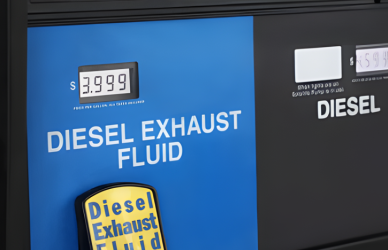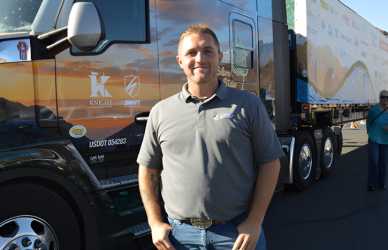The trucking industry has weathered the storm of the pandemic and it’s primed for a significant comeback. Brace yourself for a tidal wave of technology-driven opportunities that could transform your operations.
As two speakers at the McLeod 2023 User Conference emphasized, now is the perfect moment to prepare your company for the next freight boom and ride the wave of exponential change.
During a keynote address, global futurist Daniel Burruss emphasized the existence of two types of change and how businesses can leverage them to their advantage.
The first type, cyclical change, refers to changes in the economy or in specific industries. Burruss shared a compelling example of a marine business owner who experienced a significant decline in sales during a recession. This owner, however, made a strategic decision to invest in a new manufacturing plant, taking advantage of the economic cycle. This enabled the business to be perfectly positioned to meet the increased demand when the recession ended.
The second type of change is known as linear/exponential change. Burruss illustrated this with an example of smartphones. “Once you get a smartphone, you’re not going to go back to a dumb phone,” he said as an example. He emphasized that forward-thinking businesses actively seek out opportunities within this type of change to stay ahead of the curve.
Cyclical Change: Time to Fine-Tune Your Approach
In his opening speech at the session, Tom McLeod, founder and CEO of McLeod, emphasized the importance of cyclical change. With economists from both within and outside the trucking industry predicting a period of slow growth in the coming months, McLeod advises fleets to use this time to optimize their operations.
By doing so, they will be well-prepared to capitalize on future opportunities when the freight cycle rebounds. On a positive note, the anticipated recession of last year seems unlikely to occur, as trucking economists project flat to 2% growth for the remainder of this year and throughout 2024. Freight volume is starting to recover, job numbers are still increasing, and inflation rates are stabilizing.
“OK, it feels kind of soft,” he admitted. “It’s not 2021, it’s not 2018,” he said, referring to recent boom years, “But when things are stable, it’s a great time to get things done, a wonderful time to work on your business and be prepared for when stronger growth comes back.”
It’s time for a tune-up, he said, noting that when an engine needs a tune-up, it loses efficiency, loses, power, and may not last as long.
“I’ve seen people who wouldn’t allow an engine in the fleet to run rough, but they put up with all kinds of things in their business” that have similar effects to an engine that’s not at its peak.
“There are two ways to react when things slow down,” McLeod said: Hunker down, or make the best of the situation and get things set for when things pick up.
When freight picks back up, he said, “Company A who hunkered down is coming from a cold start.” Company B, which took advantage of the slow time to improve, is ready to go and has an opportunity then to pull ahead of the competition.
McLeod suggests strategies for fleets to maximize their productivity during this downtime in order to be fully prepared to excel when the opportunity arises.
Educate Yourself on New Technologies
The implementation of zero-emissions vehicles and autonomous vehicles may take time, but they will ultimately have an impact on your business, according to McLeod, and “if you’re not doing it, it’s likely your competition will.”
When it comes to electric trucks, McLeod suggests exploring if they can be integrated into your operations. Consider the local charging infrastructure and consult with suppliers and truck manufacturers.
While autonomous trucks may still be a while away, there are already trucks operating in multiple lanes, although with safety drivers.
Prepare for the future by investigating how state EV mandates and 2027 EPA emissions regulations will impact your buying cycle.
During the session with trucking journalists, McLeod shed light on the data management aspect of emerging technologies. They have been collaborating with autonomous-truck developers, offering insights into real-world operational changes.
For example, while most developers envision a hub-to-hub model for autonomous trucks on interstate highways, McLeod highlights the necessity of human drivers on both ends of the run. This poses challenges such as payment, tracking all legs of the delivery, and billing the customer.
Mark Cubine, McLeod’s VP of marketing, explained how they worked with an autonomous-truck company to create a comprehensive data flow diagram for their hypothetical operation. This diagram maps out all touchpoints, events, and communications.
“It wasn’t anything exotic for us, but for them, it was an interesting exercise.”
Unlock Your Potential
Now, while business isn’t quite busy, is a great opportunity to assess your business and find ways to increase profitability, McLeod said. Consider these areas:
- Improve automation in your back-office processes.
- Apply pricing discipline to avoid leaving money on the table.
- Evaluate your customers and network to identify unprofitable lanes.
- Ensure planning and driver management tasks are done in real time.
Remember, you may already have tools or features that can assist with these improvements. Take the time to examine your operations and become more efficient both as an individual and as a company.
According to Burruss, exploring ways to enhance efficiency is crucial for both individuals and companies.
“What are things you don’t need to be doing anymore? Is there a tool to do that?”
As an example, he pointed out that Microsoft Word has over 4,000 features, yet most people use only a handful. “But you’ve paid for all 4,000.”
Trucking software is no different.
“I suggest somebody run every single report on the menu. I guarantee there’s reports in the system you don’t even know about,” said McLeod.
Discovering and Leveraging “Hard Trends” for Success
Burruss emphasized the importance of dedicating time and effort to unlock your business’s potential.
“Hope is not a strategy,” he said. “My biggest worry for you is you’re really busy doing what you’ve always done. Today, you can busy yourself right out of business.”
There’s an old saying that if you keep doing what you’ve always done, you’ll get what you’ve always gotten. That’s no longer true, Burruss said.
“If you do what you’ve always done, you’ll get much less than you always have, because the world’s changing.”
The pandemic has sparked a surge in growth in multiple sectors, including e-commerce, remote work, tele-education, online learning, telemedicine, and cloud services.
“When you have technology expanding at an exponential rate, you’re looking at exponential opportunities,” he said. “You don’t want to squander this amazing moment in time.”
In order to seize these opportunities, it is crucial to shift our mindset. Instead of merely reacting to circumstances, we should anticipate and prepare for disruption, problems, and opportunities.
But how can we accomplish this? The task seems daunting with so much uncertainty. According to Burruss, we should start by focusing on what we are certain about.
For instance, he discussed the importance of building and maintaining relationships for the future. Ensuring that people trust your company should be a priority. Therefore, before implementing any new changes, it is essential to consider how these changes may impact trust. If the answer is unsatisfactory, it may be necessary to revise the implementation strategy.
Differentiating Hard Trends from Soft Trends
When it comes to spotting trends, there are two distinct types to consider: hard trends and soft trends. Hard trends are grounded in undeniable future facts, while soft trends are based on uncertain assumptions.
Hard trends give you the ability to clearly envision the future, while soft trends provide an opportunity to shape and influence their outcome.
Let’s dive into three examples of hard trends discussed by Burruss:
- Demographics
The aging population of Baby Boomers is an undeniable hard trend. Additionally, it’s crucial to recognize that many of them will soon be retiring, taking their valuable knowledge with them. However, this is a soft trend that can be addressed by creating a wisdom base within the company. It’s essential to involve younger generations in decision-making processes to avoid sending a message of seniority-based preconceptions.
- Government Regulations
While it may not be possible to predict all regulations, there are certain areas where hard trends can be identified. One example is cybersecurity regulations, which are almost certain to increase in the future.
- Technology
Undoubtedly, technology plays a significant role in shaping our future. Hard trends in this realm include the increasing datafication of everything, the integration of artificial intelligence and machine learning into our devices, and the rise of on-demand 3D printing. Other prominent examples involve the use of generative AI like ChatGPT, AI-enhanced supply chains, streaming data analytics, and individuals leveraging AI for augmented thinking.
“The supply chain is becoming the supply brain,” he said.
During his speech, Burruss urged the audience to allocate at least one hour per week towards breaking away from crisis management and focusing on ways to capitalize on trends and opportunities that could revolutionize their businesses.
He emphasized the importance of identifying hard trends and the corresponding opportunities, as well as recognizing soft trends and finding ways to influence them. Additionally, he advised the audience to pinpoint predictable problems that may arise and come up with effective solutions.
Lastly, Burruss emphasized the need to prioritize the top two items from the identified list as “must do” tasks and take immediate action.
Source: Trucking Info











